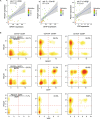Distinct epigenetic features of tumor-reactive CD8+ T cells in colorectal cancer patients revealed by genome-wide DNA methylation analysis
- PMID: 31892342
- PMCID: PMC6937914
- DOI: 10.1186/s13059-019-1921-y
Distinct epigenetic features of tumor-reactive CD8+ T cells in colorectal cancer patients revealed by genome-wide DNA methylation analysis
Abstract
Background: Tumor-reactive CD8+ tumor-infiltrating lymphocytes (TILs) represent a subtype of T cells that can recognize and destroy tumor specifically. Understanding the regulatory mechanism of tumor-reactive CD8+ T cells has important therapeutic implications. Yet the DNA methylation status of this T cell subtype has not been elucidated.
Results: In this study, we segregate tumor-reactive and bystander CD8+ TILs, as well as naïve and effector memory CD8+ T cell subtypes as controls from colorectal cancer patients, to compare their transcriptome and methylome characteristics. Transcriptome profiling confirms previous conclusions that tumor-reactive TILs have an exhausted tissue-resident memory signature. Whole-genome methylation profiling identifies a distinct methylome pattern of tumor-reactive CD8+ T cells, with tumor-reactive markers CD39 and CD103 being specifically demethylated. In addition, dynamic changes are observed during the transition of naïve T cells into tumor-reactive CD8+ T cells. Transcription factor binding motif enrichment analysis identifies several immune-related transcription factors, including three exhaustion-related genes (NR4A1, BATF, and EGR2) and VDR, which potentially play an important regulatory role in tumor-reactive CD8+ T cells.
Conclusion: Our study supports the involvement of DNA methylation in shaping tumor-reactive and bystander CD8+ TILs, and provides a valuable resource for the development of novel DNA methylation markers and future therapeutics.
Keywords: Bystanders; Colorectal cancer; Methylome; T cell exhaustion; Transcription factor; Transcriptome; Tumor-reactive T cells.
Conflict of interest statement
The authors declare that they have no competing interests.
Figures





References
-
- Scheper Wouter, Kelderman Sander, Fanchi Lorenzo F., Linnemann Carsten, Bendle Gavin, de Rooij Marije A. J., Hirt Christian, Mezzadra Riccardo, Slagter Maarten, Dijkstra Krijn, Kluin Roelof J. C., Snaebjornsson Petur, Milne Katy, Nelson Brad H., Zijlmans Henry, Kenter Gemma, Voest Emile E., Haanen John B. A. G., Schumacher Ton N. Low and variable tumor reactivity of the intratumoral TCR repertoire in human cancers. Nature Medicine. 2018;25(1):89–94. doi: 10.1038/s41591-018-0266-5. - DOI - PubMed
-
- Li Hanjie, van der Leun Anne M., Yofe Ido, Lubling Yaniv, Gelbard-Solodkin Dikla, van Akkooi Alexander C.J., van den Braber Marlous, Rozeman Elisa A., Haanen John B.A.G., Blank Christian U., Horlings Hugo M., David Eyal, Baran Yael, Bercovich Akhiad, Lifshitz Aviezer, Schumacher Ton N., Tanay Amos, Amit Ido. Dysfunctional CD8 T Cells Form a Proliferative, Dynamically Regulated Compartment within Human Melanoma. Cell. 2019;176(4):775-789.e18. doi: 10.1016/j.cell.2018.11.043. - DOI - PMC - PubMed
Publication types
MeSH terms
Substances
LinkOut - more resources
Full Text Sources
Other Literature Sources
Medical
Molecular Biology Databases
Research Materials

